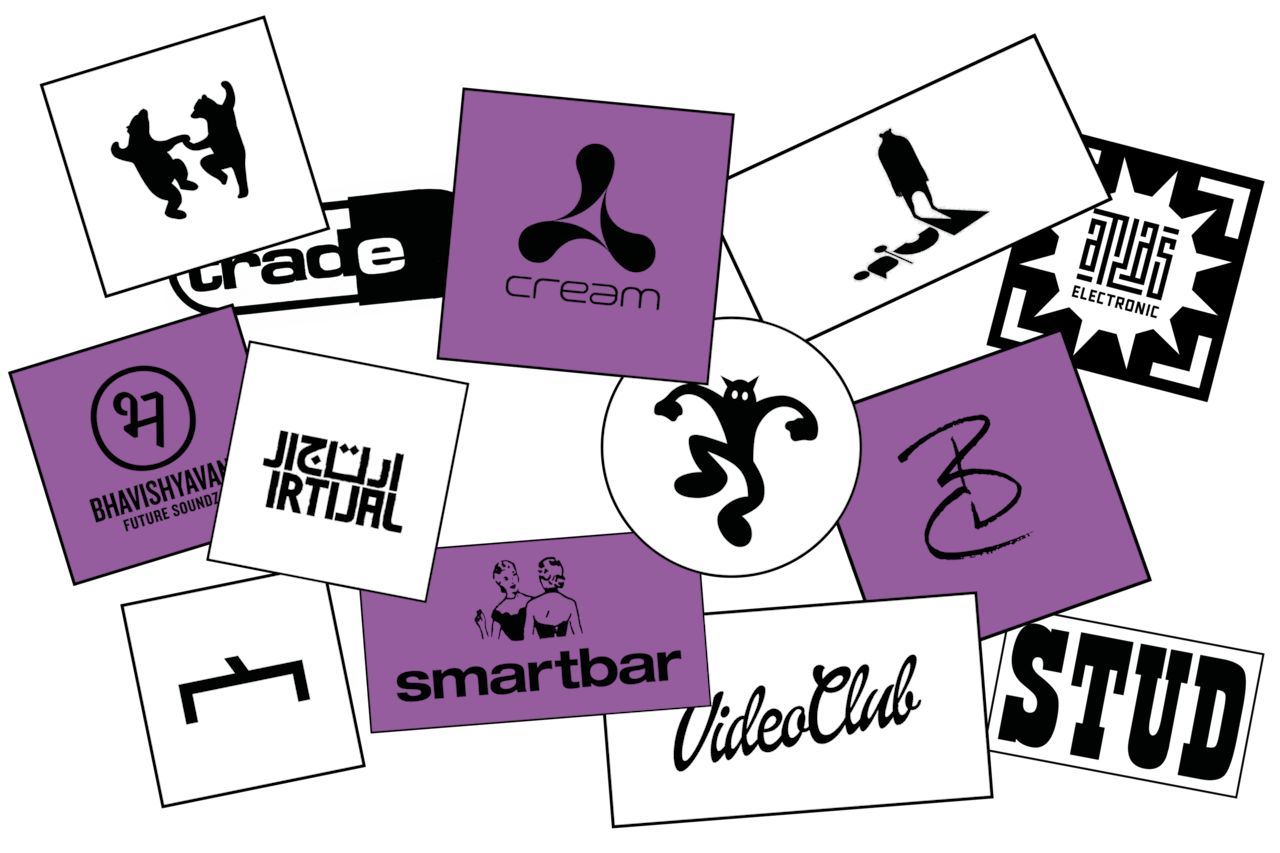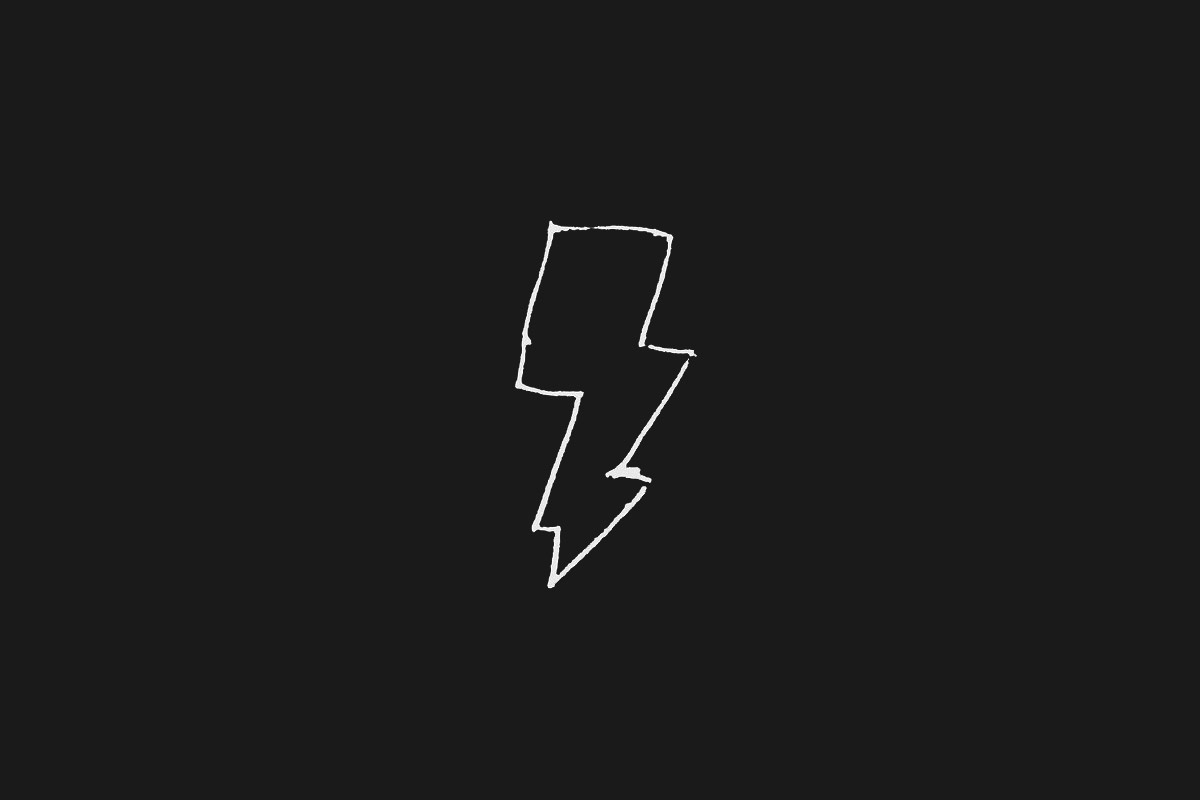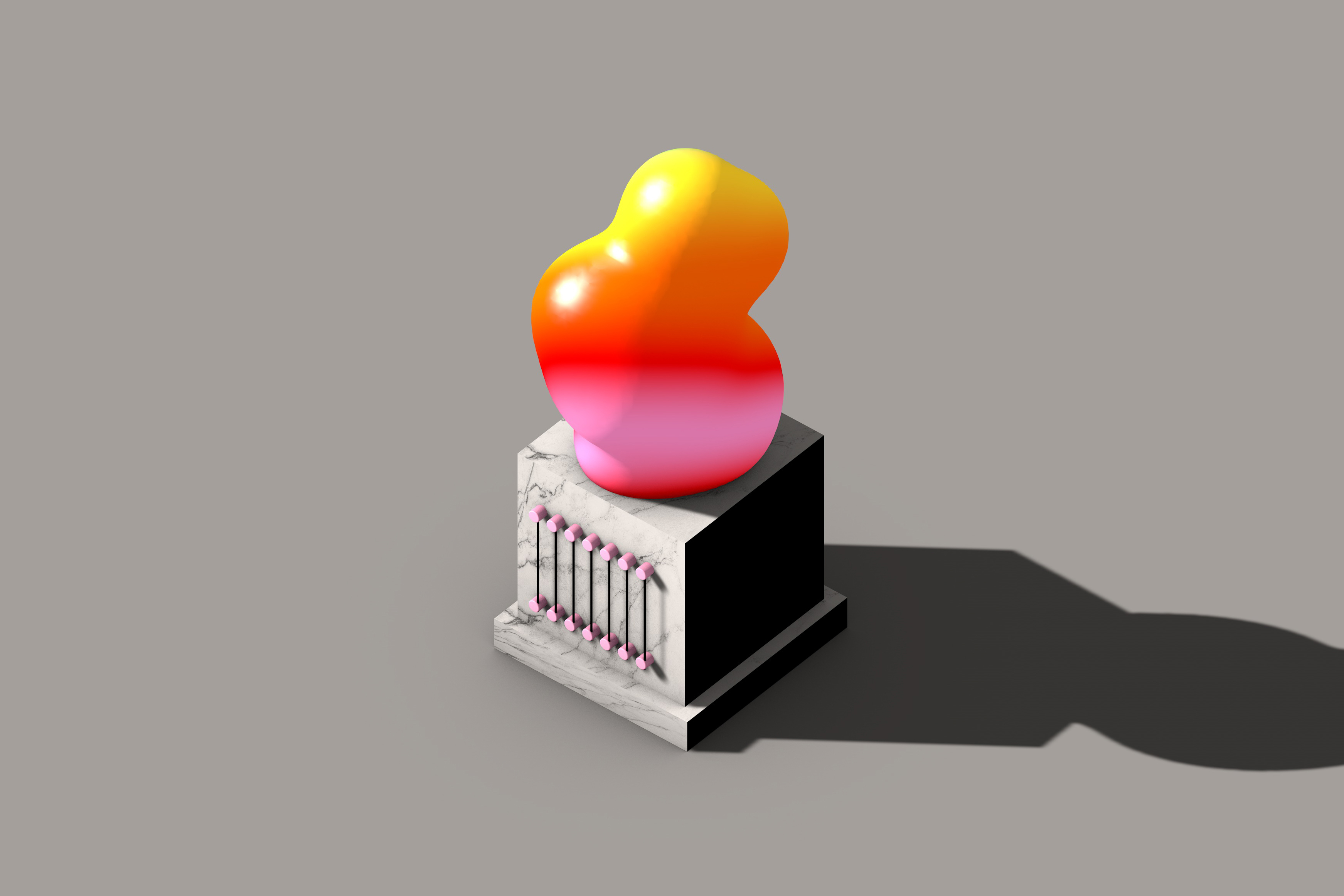
World Club Logos Explained
13 venues, festivals and club nights from around the globe share the stories behind their visual identities
Creating an original visual identity for an event is deceptively tricky. Advanced software has made it easy to over-design, adding layer after layer of glossy bells and whistles, until what is intended to make a party shine ends up an eyesore. Even the explosion of lurid creativity around acid house, or cut-and-paste aesthetic of punk zines, are now just tropes to be recycled. Thankfully, a select few parties out there buck the trend.
Some are institutions, while others have existed for only a handful of years, forging their own history by taking a sledgehammer to convention. There are those that painstakingly fuse ancient calligraphy with modern techniques, while others are casual doodles that stuck around. Whether loading a symbol with political poignance or letting monster mascots roam through the flyers, they stand a mile out.
RBMA has previously zoned in on the logos of groups, radio stations, record stores and genre tags found within a certain city’s walls. This time, we tighten the criteria while slackening the geographic specificity. 13 venues, festivals and club nights from across all six habitable continents share the intention, process, and often unusual stories that resulted in how they choose to represent themselves. You can enjoy these graphics without ever stepping foot on the premises, or even liking the music played within. What binds the disparate baker’s dozen is memorability, an intangible quality to pinpoint but instantly recognisable when you see it.
Animals Dancing (Melbourne, Australia)

Animals Dancing are one of Melbourne’s most popular party crews, with a logo so well-known they can get by promoting shows without any of the usual trappings of location, ticketing and web support: Just the date and a pair of ecstatic bears will suffice. In their ranks you can find a gaggle of the city’s current generation of breakout DJs: Andee Frost, Tom Moore and Nick Murray, AKA Otologic, and Lewie Day, AKA Tornado Wallace. They are also, according to original co-founder Daragh Kan, a unit schooled in the fine art of winging it.
The party, which evolved from one called C Grade that would run until the small hours at now-shuttered venue the Mercat, couldn’t afford anyone professional in the art sphere, so they went DIY with stencils, spray and, at first, a cheaper monochromatic option for the print posters. The name, Kan says, came about from “sitting around at Lewie’s place, looking at stuff on YouTube when Myles, one of the Mercat’s owners, searched ‘animals dancing.’ I found this hilarious for some reason, as I thought that most people would have searched for ‘dancing animals’ instead.” Still chuckling about it weeks later, Kan sketched out a logo based on a candlestick holder he found online. And the reason the bears stuck? “We considered doing a dancing alligator, but I can’t draw, so we didn’t do it.”
“There’s something ballsy about standing behind a design that’s barely changed for almost ten years,” thinks Kan, whose day job today is running 100 Burgers, a street food empire with trucks and restaurants across Australia. The most beloved twist on the format has been a rainbow iteration – although even this needed work. Kerning on the first run made it look like a biker gang patch, with “Animals” on top and “Dancing” along the bottom, so they made the outer rainbow and text come full circle instead. “San Proper told us he was going to get a tattoo of the [rainbow logo] one time,” recalls Kan, “but I kicked him out of the club because I’d never met him and just thought he was some loose bloke.” He was onto something, though: “I don’t have any tattoos, but if I ever get one it will be the bears on my butt cheek.”
Atlas Electronic (North of Marrakesh, Morocco)

Atlas Electronic was founded in 2016 by Dutch–Moroccan promoter Karim Mrabti, and a core team that straddle both nationalities. The festival takes place in the distant shadow of the Atlas Mountains, at Villa Janna, just outside of Marrakech. It is not far from a location that in 2014 gave birth to a collaboration between electronic shaman James Holden and the late gnawa great Mâalem Mahmoud Guinia. Rotterdam-based Tijn de Kok, who led the line on creative direction as art director for the first three years, saw the festival as an opportunity to facilitate further cross-cultural dialogue.
They fell short on the first attempt. Atlas offered a cosmopolitan North African experience for tourist clientele, but lacked opportunities for local musicians. The programme today is a 50/50 split between internationals and Moroccans, giving a stage to live performers like all-female gnawa group Asmâa Hamzaoui & Bnat Timbouktou and mainstays of the electronic scene, such as DJ Yasmean and label Casa Voyager. That opening edition, de Kok admits, was “a strong learning curve” that resulted in a sense of “social duty surfacing.” While being guided around the winding alleys of Marrakesh’s medina to investigate ancient plaques and insignias, the team felt so heavily smitten by the “vibrant colours, symbols found on city walls, poignant smells and warm atmosphere” of the place that they decided to rip up Atlas Electronic’s identity and start afresh on a “more suiting visual language” for the second outing.
Atlas Electronic’s integration of modern approaches into an age-old aesthetic framework now more accurately reflects the festival’s ambition to aid the evolution of Moroccan culture.
The only thing that remained was the logo. Its inspiration is derived from Kufic, a form of calligraphy dating back to the 7th century, used widely in regional architecture. What felt most fitting for a progressive music event was Square Kufic, what de Kok calls “a minimized, almost pixelated form of the more traditional decorative style.” He sketched out a logo in Adobe Illustrator, making the “Atlas” by closely following historical guidelines, and “Electronic” by applying Latin letters within the Kufic grid, arriving at a new hybrid typeface. Following a burst of flair on the artwork for 2017’s edition, 2018 set tighter limits of just four colours, as well as adding texture to the geometric system and using Arabic typography alongside the Latin alphabet. Atlas Electronic’s integration of modern approaches into an age-old aesthetic framework now more accurately reflects the festival’s ambition to aid the evolution of Moroccan culture, placing its artists in a global electronic melange whilst folding new voices into the county’s rich heritage.
Bhavishyavani Future Soundz (Mumbai, India)

Tejas Mangeshkar and a group of friends were walking along Mumbai’s Juhu Beach one day in 1999 when they happened upon a curious sight being paraded around: A miniature robot wearing giant headphones that could foretell the future. Its predictions never panned out, but the situation was an otherwise perfect catalyst for a gang of designers-by-day, soundbwoys-by-night. Written on the side of the robot were the words “Bhavish-yavani” (“future sound” in Hindi) and the display’s “kind of desi, low-tech futuristic kitsch stayed with us,” Mangeshkar has said. Bhavishyavani Future Soundz was born, taking the letter भ from the Devangari alphabet as their logo and its pronunciation (“bha”) as their abbreviation. The robot even became BHA’s mascot.
Turned off by local DJs who would loop Bollywood vocals over dated ’80s pop, and fed up with the one-dimensional read of India’s scene as all about Goa, BHA instead pushed drum & bass, trip-hop, techno and whatever else fit their self-styled “Asian Breakbeat Electronix.” Regulations on events at the time were light touch, allowing for anything-goes rowdiness that attracted a loyal coalition of hippie burnouts, ne’er-do-wells and sub-worshippers. Mangeshkar and Kurnal Rawat, who had an agency called Grandmother, with clients including Sony and the Southeast Asian TV station Channel V, were hot property, so every young creative and corporate parasite in Mumbai scrambled to work with them as the party exploded onto the scene.
Whether making riffs on the everyday churn of bustling cities, utilising the kind of day-glo graphics popular in video games of the early 2000s like Jet Set Radio and SSX, or adapting humor that was “like Indrajal Comics on acid,” as co-founder Ashim Ahluwalia observed, their flyers were instantly iconic. As opportunities came to book artists like Laurent Garnier and expand the brand into full festivals, the sound slowly changed from the junglist romps of Aphrodite and Aphex Twin to the trippy wanderlust of DJ Koze and Cobblestone Jazz. But 20 years on, BHA has not lost their eye for sharp design, nor wavered from their original ambition: “Fast Dancing For A New India.”
Cream (Liverpool, United Kingdom)

Crop circles, dental braces, shaved haircuts, embossed on airplane wings: Cream got around. In 1992, when Rob Petrie – fresh out of a graphic design degree at Liverpool University and working for Mark Farrow, Pet Shop Boys’ in-house art genius – got the brief for a forthcoming club night, it was infamously brief: “Something like the Nike logo.” Manchester’s Haçienda, Petrie says, “was already renowned for its slick industrial chic, so I felt that the Cream logo itself should feel more harmoniously organic and playful. Something with a subtle yet cool personality.” As well as Nike, the yin-yang symbol, Olympic rings, and car manufacturers like Toyota, Audi and Mitsubishi were used as sources of inspiration for a piece of work that cost only £3,000. Petrie had a steadfast belief that there should be “absolutely no early [Adobe] Illustrator embellishments like gradients, bevels or tricky overlaps. This simplicity has proven to be key.”
I saw a lad with his top off with a 10 centimer-wide Cream logo tattooed on his chest. I was pretty gobsmacked.
Working with just one studio Mac and an A4 layout pad, once the three droplets of cream – not sperm, he is at pains to point out – fell into place, “pointing away from each other but still inherently linked,” it was clear they had got it. “To create a perfect balance,” Petrie then re-did each droplet “using just three circles. Therefore the logo is held together within nine invisible circles in total.” It wasn’t until a night out at Nation, the club where James Burton, Darren Hughes and Andy Carroll made Cream into a fixture, that Petrie realised quite how deep the Liverpudlian attachment to his handiwork ran: “That’s where I saw a lad with his top off with a 10 centimer-wide Cream logo tattooed on his chest. I was pretty gobsmacked.”
From there, one of the most ambitious and ubiquitous advertising campaigns in music history took off. The logo was physically “constructed as an architectural perspex model, cast in chrome, made of flowers, moulded into a snow-dome, formed as an inflatable” – as well as reproduced in Petrie’s favourite, the first run of Cream Live releases, a double CD that came in five different colours of rubber: “Soft to the touch and smelled great.”
As the 20th century drew to its conclusion, Cream’s popularity, and the music swilling around the club culture, had gone supernova. Players from Liverpool F.C. would turn out to Nation every weekend, and even don cream suits in homage. Tongue-in-cheek 1999 flick Kevin & Perry Go Large featured a scene where the duo hit up Amnesia, Cream’s home in Ibiza. Hubristic plans for a Millenium Eve blowout in venues across the world were hatched – many of which wound up catastrophically undersold white elephants. By 2002, the bubble had burst. “Cream were very competitive amongst other clubs at the time,” Petrie says, such as “Ministry of Sound, Renaissance and Gatecrasher. They wanted to be seen as the biggest and the best… Though still proud of the logo, I felt that the whole global-domination-superclub approach was out of step with the times.” With Cream now not far off its 30th anniversary, “Scousers remain extremely proud of the club’s reputation.” To this day people still “politely freak out” when the cream drops that Petrie was behind a logo that changed the face of dance music.
Irtijal (Beirut, Lebanon)

Irtijal has expanded from three concerts of free improv in 2001, to a multi-day festival in 2003, and onto today, where it is the longest running Lebanese event of its kind. Irtijal is also a pacesetter for the burgeoning Arab experimental scene at large, something co-founder Mazen Kerbaj would have called “nonexistent ten or 20 years ago.” Kerbaj, a trained comic artist who holds a degree from the Lebanese Academy of Fine Arts, is tasked with the annual themes. He is also a frequent performer, both solo as a jazz trumpeter or in collaborative ensembles, be that with local musicians like Rabih Beaini, or international guests, like anarcho-punk outfit the Ex.
The civil unrest that blights Beirut to this day has an impact on Irtijal – one regular booking at the festival, electroacoustic musician Tarek Atoui, was detained during the 2006 protests for collecting sound recordings on the streets, and beaten so badly he suffered permanent hearing damage. But the city’s instability has never yet forced a full cancellation, a sign of the community’s resilience. Kerbaj’s annual themes – leaping off the page in a fixed palette of red, black and white – bring out the sense of unease with panicked faces, privacy invasion and, on occasion, outright references to tools of war. But his doodles pull the other way, too: Showing a slate of grinning attendees, whistles as “Survival Kits” or musicians wrestling vital noise from their tools of resistance.
Life Force (Various, Japan)

September 1993 was the beginning of Japan’s open-air party tradition, and Life Force was the seed. “I intended to introduce the shock which I got in ‘Techno Rave,’ received in my life in Britain,” the party’s founder and all-around free spirit Massa Horrie writes over email, with resident DJ Mana assisting. Massa traded playing djembe with Hawkwind’s Nik Turner’s band in Wales for something akin to musical missionary work back home. “At the time of social maturity” in the nation, pushing anything too powerful would have been “still premature.” Rather than exporting the wanton bangers popularized by the lawless Spiral Tribe massive, garage house and deep Detroit techno were favoured instead, as well as a slice of the “full-fledged depth of London [club music] – which shocked Tokyo enough.”
Utilising the help of British DJs and local sound technician Yutaka Asada – who had worked broadly with everyone from Adrian Sherwood to the Black Dog, and later collaborated with Massa and David Mancuso on the production and custom soundsystems of Mancuso’s multi-city 1999 Japan tour – Life Force began in earnest. As Massa anticipated, they did instigate a fair shock: One attendee of the inaugural edition slit his neck, having reached such transcendence he wished to never come back down – Massa saved his life. From the beginning Massa took on most of the artwork, as well as chipping in with everything from lighting and photocopier access to wildflower arrangements, which formed a creative “whirlpool” that Massa cites as “the ongoing source of our ‘corps of life.’”
Unusually, Life Force has two logos. The more common is the crystal dagger on the globe. The other comes out infrequently, but truly catches the eye: the “Dancing Monster.” Kosuke Obayashi Macca, in charge of flyer design for Life Force from the beginning, was behind both. Life Force events carry on to this day (although are more likely to be found in warehouses than foggy forests). No one can divine why Life Force sometimes opts for the crystal dagger, and sometimes brings the Dancing Monster out to play for its “Giant Step~” series, though. Massa and Mana skirt the question, but the suggestion is that “the unique root of vitality” does not require explanation.
宀 (Hong Kong)

“In Hong Kong,” the team behind 宀 (romanised as Mihn, as it is pronounced in Cantonese) say, “if you follow the rules, you’re fine. The authorities will check the papers. If the papers are okay, everything is okay.” But in the time between conducting the interview for this article and publication, Hong Kong has been put under severe strain. Mihn, which opened its doors on June 1st, 2018, began being subjected to pressure from the authorities around the time of its first anniversary. The club passed their checks: They hold a 24-hour alcohol license, secure visas for all bookings, and installed custom acoustic doors to isolate the sound, even though the capacity is a mere 100. Yet the district they reside in, Sheung Wan, has still suffered property damage and seen tear gas-launching riot police line its streets – no one is fully isolated from the civil unrest that has rocked Hong Kong throughout the summer of 2019.
宀 were wary of Asian clubs that would adopt German or English names – they wanted something regionally-applicable, as well as sending the right signals.
Mihn launched with a twofold ambition. First and foremost, they wished to bring quality DJs to an fluid, liberating space intended to rival the best spots in Seoul and Tokyo, cities they say get the lion’s share of attention in East Asia. The team – a mix of locals and Europeans who have connections to Taiwan’s Organik Festival, as well as German label Klasse Wrecks – also wished to provide a reprieve from Hong Kong’s stultifying mix of capitalist strictures and patriarchal “microaggressions” that would sour nights out. The club launched with a safe space manifesto, which is kept by the entrance. It functions like an airplane instructional video, something regulars are innately familiar with and might skip over, but that first-timers are prompted to learn and absorb. Certain phrases from it (Express Yourself; Feel Free To Feel Free) recur in Mihn’s promotional material alongside grainy shots of chains and exposed flesh.
The name ties it all together. Mihn were wary of Asian clubs that would adopt German or English names – they wanted something regionally-applicable, as well as sending the right signals. “It couldn’t be any random Chinese name,” they say. “It had to be something with a special meaning and something that will be difficult to find; something maybe obsolete.” They agreed upon 宀, with additional input by Taiwan based designer Jill Chien. Academically known as the Radical 40, it is a character that can only be used in the construction of other words in Chinese script. It functions as a roof, but cannot stand alone. “Chinese readers will see that and they will be very confused. ‘I know this but I don't know where from.’ Then you tell them and they go: ‘Oh yes, of course.’ It's a very specific, subtle way to express protection, cover, safety, security, shelter in the Chinese language.” A shade of pink to double underline the queer-friendly intent, and the logo was complete.
Opium (Vilnius, Lithuania)

In 2019, Opium is recognised as not just one of Vilnius’ best clubs, but something akin to an equivalent Robert Johnson for the Baltic region – a small space with the intensely spirited atmosphere of a pub lock-in, and one that international DJs praise as the epitome of a good time. The origins of Opium are a tad less inspiring. In 2009, an idea was hatched in the basement of a local Asian fusion restaurant to establish an afterhours for another club nearby, with the name coined solely to carry on the orientalist theme of its parent. As it grew in stature, says head of programming Vidmantas Čepkauskas, it began to stand for “fusion energy: Showcasing eclectic tastes musically, embracing different identities visually and [being] inclusive socially.”
“There has never been a Lithuanian Bauhaus or any other landmark school or movement of design,” Čepkauskas explains. “Everything that started in the early 20th century was ended abruptly by Soviet occupation. These days it’s a mixture of all the things.” Leaning into a lack of precedent, the initial idea for Opium was to have “ever-changing video projections on the walls, rather than active club lighting.” Once the walls were done up in gleaming white, “it immediately felt like being in the middle of snowy mountains. And that’s where our Yeti came into play.” (Yeti, it should be noted, lacks a direct translation in Lithuanian. The closest descriptor Čepkauskas could reach for was “Wild Man of the Snows.”)
Andrius Lėkštutis originally designed Opium’s logo, but it falls to Vytis Gruzdys to apply the Yeti to the club’s varied promotional art today. The “prosaic reason” that the logo stuck, Čepkauskas admits, was to get around the State Patent Bureau of the Republic of Lithuania, who would not originally grant a trademark due to Opium’s assumed connection to opioids. The romantic view might be that a ghostly apparition is perfect for a sweaty night-time haunt. And though you can’t see it on the page, in person, “the Snowman’s eyes are blazing. And it’s not just any blaze, it’s an electrical blaze. The Snowman is electrified, its eyes keep on radiating special energy and giving special powers” – just as Opium does to Vilnius.
Rainbow Disco Club (Honshū region, Japan)

The three founders of Rainbow Disco Club have a track record in establishing a presence for events, as well as handling the nuts and bolts of running them. In the mid-2000s, Carlos Gibbs and partner Laurent Novatin were whipping up interest in their Redbox series by using a cubic mascot that was hauled around from party to party. It was intended as an aspirational symbol and a talking point, as well as simply a red box to snap fun shots of. The buzz moved from San Francisco to Tokyo when Gibbs did. There, he and Novatin linked up with Masa Tsuchiya’s Raft crew and cornered the local market with some blockbuster Halloween and New Year’s Eve events. In 2009, it was decided that an outdoor festival was the next step for expansion – and a way to better indulge their creative sides. As Gibbs says from his current home in Shanghai, Masa “was a scout for TV shows; my major in college was in stage design… Masa’s the guy that finds the location, and I’m the one that makes it look cute.”
Cuteness and classiness are the elements that form Rainbow Disco Club’s chemistry. The vibe is that of a village fête, adorned with fairy lights and awash with colour, which just so happens to have world-class selectors pulling the tunes. Charming photos of DJs hammering records with their kids acting as cheerleaders are a useful downpayment in encouraging international visitors of all ages to make the trip over to Japan and be part of the fun. The verdant forests of Iku seal the deal, a dramatic backdrop for the triangular main stage and inverted neon triangular neon that rests below it.
The logo is Gibbs’ own handiwork. It started out as the full festival name, scrawled as if on some invisible dotted line, before becoming a classy acronym able to be replicated in a single stroke. “The simplicity of space,” Gibbs says, underpins both the production and the branding. Kikiorix, one of the resident DJs, is in charge of the flyers. The current motif, an extension of RDC 2017’s theme of “Beyond Space And Time,” is a mixture of UFOs, pyramids, squiggly lines and a mask. Combined, it forms “a happy medium,” something to spark gooey feelings of space-travelling mysticism that appeals to late 40-something Trekkies like Gibbs, younger partygoers who turn out religiously for every DJ Harvey appearance, or the kids of either camp. Gibbs’ company, the Texture Group, makes and ships out physical props for each Rainbow Disco Club sister event, to instil a sense of continuity wherever they go, be it the beachfront opulence of Bali’s Potato Head or the industry scrum of a Rush Hour co-pro at ADE. At least one glowing triangle will always be present; the knack for using geometric glyphs as a lure never left.
Smartbar (Chicago, USA)

The story of Smartbar’s logo has never before been publicly told. “No one ever really thought to ask,” laughs Joe Shanahan, who founded the club in 1982. When the request for this article came in to their press desk, the owner opted to step in, as the true origin is not even really known amongst the staff, let alone resident DJs or faithful regulars, even though many bear tattoos of it, wear pin badges, or have made DIY jacket patches. If they were aware that Shanahan lifted it off his dry cleaning receipt, they might have drawn pause.
Shanahan was working as a waiter and bartender in 1980, with “a series of shirts and slacks that I needed to be cleaned on a regular basis.” On one trip to the now-defunct Tic Toc chain of cotton shops (seen here in 1973), he needed to take a note, and was handed a receipt book by the clerk. The simplicity of the design struck him there and then. Shanahan adapted “Latest Creations” as a name for his first production company, and used the conversing pair of women in a variety of ways going forward. “Once I began to get the Smartbar motor moving,” Shanahan recalls, “I took the ladies, put them in a circle and placed the word ‘Chicago’ underneath.” A big fan of both punk’s cut-and-paste aesthetic and Malcolm McLaren’s flexible approach to intellectual property, his act of clip art banditry went undetected. Plus, he says, “why would I ever want to change it? It’s strong. It holds up.”
With one woman facing forward and the other back, it struck Joe Shanahan that “what [Smartbar was], and will always be, is a place that walks into the future competently, but honours the past as the foundation.”
Smartbar took its name from the John Kennedy Toole’s book A Confederacy of Dunces. Through a racket of pontificating drunks in New Orleans’ French Quarter, a plan is hatched to escape somewhere better: “Let’s go to a smart bar.” Just as the name is situated in the American literary canon, the club’s rep as a hotspot for house places it in the musical. With Frankie Knuckles installed as the first resident DJ and the new sound of house exploding in the ’80s, Shanahan began to read an additional significance between the logo’s lines. With one woman facing forward and the other back, it struck him that “what we were, and will always be, is a place that walks into the future competently, but honours the past as the foundation.”
Unlike Smartbar, the larger Metro venue, which resides in the same building, has switched design a few times. For years it was an oikish, back-of-the-napkin scrawl; then a more cabaret-esque variant. A polite dressing-down from Peter Saville – who became close with Shanahan alongside New Order, Haçienda DJs and other travelling house heads who fondly referred to Chicago as “Manchester by the lake” – made Shanahan propose that Saville take it on instead. “It was a bit of a dare, asking one of the greatest graphic designers of our time to redo it. Several months later, I got a full alphabet and the encircled M through.” Fond as Shanahan remains of classic design work, he appreciated early that nothing in art or music is safe from some gentle bastardisation. That spirit still maintains: “While on holiday, and I saw that someone had appropriated Joy Division’s Unknown Pleasures artwork but flipped the word Corsica underneath it. I sent it to Peter on the 40th anniversary of the album’s release, just like, ‘happy fucking anniversary.’ You know what I should do? I should get my local t-shirt guy to send the Mancunians a rough bootleg of that cover with Smartbar underneath it. They would love it.”
The Stud (San Francisco, USA)
.e92e54f4.png?auto=format&w=300)
The Stud is steeped in history. It opened its doors on May 27th, 1966 with a horseshoe bar front to enable easy cruising, hay bales to rest on and all manner of other cowboy hat-tips to the country-and-western theme. From there it became a place of many San Francisco firsts, reflecting the churn of social and cultural progression: The first gay spot to have women bartenders; pioneers of experiental drag shows with an anarchic bent, forecasting the popularity of shows like Drag Race; throwing dedicated hip-hop and techno parties before the rest. Following a location change and an existential threat of redevelopment in 2016, an innovative co-ownership model has allowed it to subsist in the face of San Francisco’s soaring rents and constant squeeze on the arts community. “People woke back up to the power of noisy queens,” says Marke Bieschke, one of the 17 co-owners (and, full disclosure, a frequently contributing writer for RBMA). Drop the “back,” and that is a useful summary of the Stud’s overall resilience and appeal.
On the face of it, the Stud’s logo is the most blunt of all gathered here: the venue’s name, rendered in a typeface that screams yeehaw, crowding out all but a little available room within the black border. For Bieschke, “a total Barthesian graphic design history geek with a specialty in semiotics,” this fixed visual signature gives them integral integrity. At just a glance, locals “get both a vintage flashback that represents the city’s long queer history and a beacon that welcomes all genders, sexualities, shapes, and colors. Our history with punk and rave – which emphasized both the importance and the deconstruction of branding – led us to keep our logo as it is, rather than submit to rebranding trends.”
Other members of the Stud Collective, including designer/publicity manager Neven Raja and event programmer Siobhan Aluvalot, have ulterior roles as guardians-in-effect, even as the Stud’s remit has expanded from leathermen and the occasional Etta James drop-in. With everything from “all-night bangers with Ben UFO and Octo Octa to trans fashion shows and femme burlesque night,” Bieschke says, “we couldn't possibly apply an overall branding contiguity without blotting out some of the personality of each event.” The lone constant on all flyers are four instantly familiar letters, lined up and ready to wrangle.
The logo, which matches the Durango font almost perfectly, only changed once – briefly. It became “a tiny bit more blocky during the ‘ironically generic’ phase of ’90s branding,” Bieschke explains, before reverting “to its serif-y self.” A twist imbued it with added poignance the decade prior, as artist Nayland Black paraded flags and banners around the city reading “DUST;” a statement about the devastation of AIDS, as well as a prescient look at external forces during the Culture Wars that would have liked to finish the job. In spite of all this, the sign found outside the current location of 9th and Harrison is the same that proudly hung outside Folsom and 10th. A bulky lightbox has been added, sitting at a counterpoint to the weather-worn version, but a half-century of roiling changes has not yet dimmed the shine of the original.
Trade (London, United Kingdom)
.05784736.png?auto=format&w=300)
Few British club nights will ever match the notoriety and deviance of Trade. Founded by Laurence Malice in 1990, it ran for 25 years in various guises, with a Sunday service at former London haunt Turnmills the party’s peak. Hard house would ring out from 3 AM until the early evening as a veritable meat market took place. It inspired such loyalty that one ailing regular asked in their will for their ashes to be scattered on the dancefloor as Tony de Vit played.
“You would stand next to a prostitute, a gangster, a raving queen, a football hooligan, and someone who had brought their mum along,” remembers designer Martin Brown, known as B-ART, who slowly took over responsibilities from TradeMark, AKA Mark Wardel, as digital techniques supplanted hand-drawn sketches and Xerox scans. “It was run like an enthusiastic youth club for very bizarre youths. Although it was a complete Dante's Inferno of craziness inside, as a business, it was vaguely under control.”
Following a logo-less and somewhat flat opening six months, Wardel hit upon a design that riffed off Mantronix sleeves, adding a Eurostile font and dialling up the similarities to speed capsules that were popular at the time. Originally made for T-shirts, the “e” was highlighted at the end, a wink-nudge made doubly conspicuous by the logo’s original subheading of “No Speed Limit.” Police were naive enough to miss it. Punters, though, got the gist.
A fact-finding expedition to New York in the club’s first year went awry – “we didn’t find any facts… we just kind of lost it,” smirks Wardel – but the club’s core influences of “pop art, Soviet-era stuff and Basquiat” were eventually agreed on. Trade’s niche of “stealth humor” was soon all over an assortment of “risqué and blasphemous” adverts and flyers, recalls Brown. Even after a slick overhaul in line with prevailing Y2K aesthetics, the ballsiness remained. They understood when the public was not in a laughing mood, though. For every Easter “Res-Erection” and “White Christmas” that flirted with Britain’s capacity for public outcry, there were Stateside events postponed in autumn of 2001, and no more Princess Diana lookalikes were permitted to appear in print or roam the dancefloor after 1997.
Wardel and Brown speak fondly about contemporary London queer parties like Adonis and Chapter 10 that swing back to a more cheeky era for promotion, following a period of bland corporatization in the 2000s. But Trade’s tactic of making mischief to build a fanbase is unlikely to be repeated. “We had a strong physical presence,” remembers Brown. “One year we sent out 2,000 Valentine’s cards, with nothing but a heart on the front and a hand-written message inside: ‘Meet you at Trade. Usual place.’ People all over London were receiving these things, with their partners going: ‘What the fucking hell is this?’”
Video Club (Bogotá, Colombia)

Since opening in 2016, Video Club has been a key space within the urban sprawl of Bogotá and the celebrated contemporary Colombian electronic scene. Backed by a 28-strong coalition of architects, interior designers, promoters and other investors, the two-story venue has been carefully arranged so that the elements are in concert with one another. Reclaimed brickwork taken from the city’s industrial spaces and old restaurants imports a sense of history. A mosaic of Mondrian-aping stained glass on the top floor lets light creep in, adding a natural complement to the professional rig at work. A rooftop terrace lies within earshot of the dancefloor, enabling hang-outs all year round in the consistently pleasant Andean climate. Yet none of this meticulous consideration would be apparent from the club’s outfacing design. Video Club’s art is schlocky and slapdash, and the logo is lifted from a rather inconspicuous source: Barbie dolls.
Enrique Leon, music programmer and resident DJ, says this disjunct between respectable decor and disreputable graphics was deliberate – sort of. The artist Sofía Reyes, a fixture in local galleries and expos, has what he calls an “aura of great disruption.” Video Club’s nicked signature has since been worked into send-ups of NASA, and onto various playful, low-res, garish flyers that are united by the quality of being “fugly.” Fugliness, however, is not everyone’s idea of fun. “We invited Solar and Tyrel Williams a couple of years ago,” Leon recalls, “and we asked for a little asset to share on social media. Sofía submitted a video of human dummies getting run over by trucks. All the time, booking agencies were balking. They came back to us complaining that the artwork does not represent their artists. And we’re like, ‘Yeah, we get that – but you maybe you’re not getting us.’”
Video Club’s booking policy is at cutting edge of house, techno and club mutations of the Latin diaspora. Even this can be a challenge to push through in the city. Leon points to likeminds in Mexico City, at club Yu Yu, and Copenhagen, with the party Self Disrupt, that share a similarly bold aesthetic and musical outlook, but probably have it easier to get over the line. He admits to asking himself: “Should we be doing this? Are we doing the right thing? Look at other clubs: They have slick fonts, amazing graphic design, a tasteful way of presenting themselves.” But the realisation dawned that Reyes’ style was the (im)perfect embodiment of Video Club’s mission to provide something different, and that being adventurous a noble pursuit in itself.
Header image © Johannes Ammler

